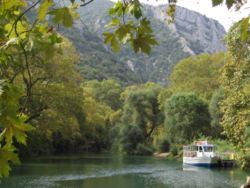Watercourse Pineios | ||
 | ||
Floor elevation approx. 267 metres (876 ft) Long-axis length 12.4 kilometres (7.7 mi) Width 0.7 to 1.5 kilometres (0.43 to 0.93 mi) | ||
The Vale of Tempe (Greek: Τέμπη) is a gorge in the Tempi municipality of northern Thessaly, Greece, located between Olympus to the north and Ossa to the south. The valley is 10 kilometers long and as narrow as 25 meters in places, with cliffs nearly 500 meters high, and through it flows the Pineios River on its way to the Aegean Sea. In ancient times, it was celebrated by Greek poets as a favorite haunt of Apollo and the Muses. On the right bank of the Pineios sat a temple to Apollo, near which the laurels used to crown the victorious in the Pythian Games were gathered.
Contents
- Map of Vale of Tempe Kato Olimpos 400 07 Greece
- Tsgs vale of tempe trailer
- Local history and legend
- Lemprire
- Recent history
- In literature
- References
Map of Vale of Tempe, Kato Olimpos 400 07, Greece
The Tempe Pass is a strategic pass in Greece since it is the main route from Larisa through the mountains to the coast. Though it can be bypassed via the Sarantoporo Pass, the alternate route takes longer. Because of this it has been the scene of numerous battles throughout history. In 480 BC, 10,000 Athenians and Spartans gathered at Tempe to stop Xerxes's invasion. However, once there, they were warned by Alexander I of Macedon that the vale could be bypassed and that the army of Xerxes was overwhelmingly large; accordingly, the Greeks retreated.
Tsgs vale of tempe trailer
Local history and legend
The Vale of Tempe was home for a time to Aristaeus, son of Apollo and Cyrene, and it was here that he chased Eurydice, wife of Orpheus, who, in her flight, was bitten by a serpent and died. In the thirteenth century AD a church dedicated to Aghia (Saint) Paraskevi was erected in the valley.
During the Third Macedonian War in 169 BC the Romans broke through Perseus of Macedon's defences here and later defeated him in the Battle of Pydna. During the revolution of Andriskos in 148 BC the valley was the site of another conflict. There were other battles fought there during the barbarian raids that mark the end of the Roman era in Greece and in Byzantine and Ottoman times.
Lemprière
John Lemprière in his Classical Dictionary gives this description:
Tempe, (plur.) a valley in Thessaly, between mount Olympus at the north, and Ossa at the south, through which the river Peneus flows into the Ægean. The poets have described it as the most delightful spot on the earth, with continual cooling shades, and verdant walks, which the warbling of birds rendered more pleasant and romantic, and which the gods often honored with their presence. Tempe extended about five miles in length but varied in the dimensions of its breadth so as to be in some places scarce one acre and a half wide. All vallies that are pleasant, either for their situation or the mildness of their climate, are called Tempe by the poets.
Recent history
Tempe has become notorious for the poor condition of the road passing through it and for horrible accidents that have happened there. On October 4, 1999 a bus carried some PAOK fans who returned from a match in Athens crashed with a truck, coming from the opposite direction. The result was 7 deaths, 6 PAOK fans and the bus driver.
The most severe happened in 2003: an entire 11th grade class of 21 students from the village of Makrochori (Prefecture of Imathia) perished when a truck carrying plywood, coming from the opposite direction, hit their bus on its side. Although the driver was able to reduce the truck's velocity in just a few seconds, sideways momentum was conserved by the plywood which detached from the vehicle and sliced into the left side of the coach, instantly killing many of the passengers.
On December 16, 2009, a small rockfall occurred. No damage or injury occurred. The road was subsequently closed, and during the inspection the next day a massive rockslide occurred, killing one person. The road remained closed until May 2010 while rocks were scaled off the cliff faces above the road, and rockfall protection fences were built.
The US city of Tempe, Arizona, and the Sydney suburb of Tempe are two locations named after it, as is a farm in the Eastern Cape of South Africa, with nearby farms named Olympus and Ossa. Th Vale of Tempe Road tracing a small valley in Penang, Malaysia, and Tempe Terra on Mars are also named after it.
